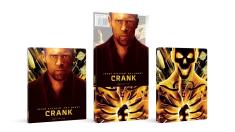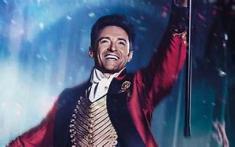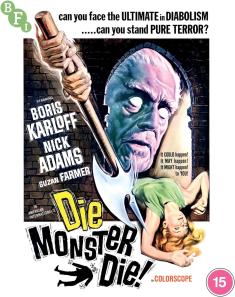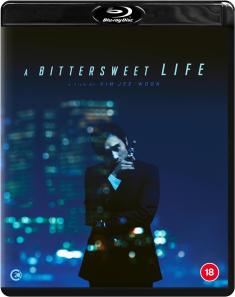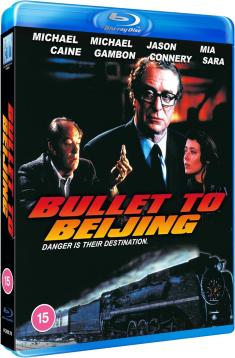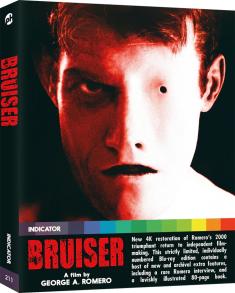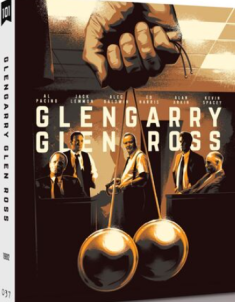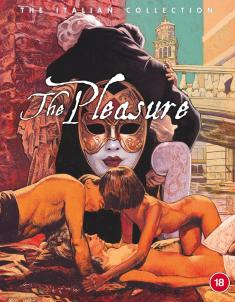Forbidden Planet
Overview -A starship crew goes to investigate the silence of a planet's colony only to find two survivors and a deadly secret that one of them has.
Storyline: Our Reviewer's Take
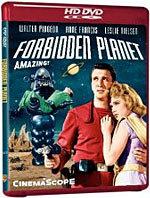
More than any other genre, science fiction seems to be able to withstand the ravages of time. No matter how chintzy, no matter how cheap, no matter how dated, there is something wonderfully endearing and charming about even the clunkiest science fiction films of the past. Certainly, 1956's 'Forbidden Planet' is not a bad film -- in fact, it is perhaps one of the genre's finest classics -- but it is fair to say its special effects are woefully archaic and its narrative conventions entirely cliched. Yet, like all good science fiction, because it dares to envision a potential future that is both darkly complex yet staunchly idealistic, it retains a timeless appeal that transcends its limitations. Perhaps the kids of today might mock 'Forbidden Planet,' but in some ways, the film remains as relevant today as it was fifty years ago.
The plot of 'Forbidden Planet' should be fairly familiar to anyone who is a fan of the sci-fi genre. In the future, a starship crew is sent to investigate a remote planet after contact is lost with its human colonists. The ship's team, led by Commander John J. Adams (Leslie Nielsen) and Lt. 'Doc' Ostrow (Warren Stevens), find only two survivors, the seemingly brilliant Dr. Edward Morbius and his beautiful but naive young daughter Altaira Morbius (Anne Francis). Unbeknownst to the astronauts and Altaira, Morbius holds a deadly secret about the planet, one that blurs the human and the monstrous in a way no one could ever have imagined. With the help of the advanced android Robby the Robot, Adams and Ostrow attempt to save Altaira and defeat the evil Morbius has unleashed.
The first word that sprang to my mind while watching 'Forbidden Planet' was "pulp." But what great pulp this is. Sure, the film is dated in almost every way -- the pacing is leaden, the acting stilted, the effects often hilarious and the film's unusual synthetic music score (aka, the "electronic tonalities") grating to the extreme. Yet 'Forbidden Planet' remains oddly compelling. In fact, it is prescient. I won't spoil any of the film's surprises, but the moral issues and futuristic themes at the heart of 'Forbidden Planet' are not unlike many that we deal with today. What separates human from machine? Man and monster? When does technology cease to aid our lives but instead threaten to take it over? And what of man's darkest fears of the future? Do they not actually come from inside of us -- from the deepest recesses of our subconscious -- rather than from outer space? Given the runaway xenophobia of the '50s, it was easy to see why 'Forbidden Planet' was such a hit back in its day. But given our own current terrors of depersonalization in the face of rampant technology, the film still delivers plenty to think about in 2006.
That said, I'm not sure if 'Forbidden Planet' holds up nearly as well as other great films in the sci-fi pantheon. Unlike the 'Star Trek and 'Star Wars' series, '2001: A Space Odyssey' and 'The Day the Earth Stood Still,' 'Forbidden Planet' isn't really that much fun. Dramatically, it is quite inert. Despite a couple of brief action scenes, the charming Robby the Robot and a laughably-forced (however enjoyably kitschy) love story between Adams and Altaira, the film drags. The direction by Fred Wilcox is also not nearly as inventive as anything Robert Wise, Stanley Kubrick or Howard Hawks ever did with the genre. Indeed, the camera is always bolted down front and center, as if we are watching a stage play. And I also cared not one iota about any of the characters, at least the human ones.
Yet, there is enough of interest intellectually and thematically going on in 'Forbidden Planet' to make it well worth visiting if you're a fan of the genre. If nothing else, it deserves a place in canon of the genre just for its influence alone. And darn it if fifty years on, that Robby the Robot doesn't still give C-3PO and HAL a run for their money as the coolest android in the history of cinema.
Video Review

'Forbidden Planet' was recently restored by Warner for the film's 50th anniversary, and reissued on standard-def DVD in a very nice two-disc special edition. That same remaster now makes its high-def debut on HD DVD, and it is another very impressive effort from the studio. It is clear a great deal of attention was paid to cleaning up the film's source materials, with a very smooth, rich and detailed presentation that I can't imagine any fan of 'Forbidden Planet' not loving.
After years of suffering through poor pan and scan versions on video and broadcast television, this 2.40:1 widescreen and 1080p/VC-1 video transfer is quite a revelation. Aside from consistent grain appropriate to the source material, any print dirt is quite minimal and all major blemishes, splice marks, etc., have been eradicated. Blacks are no longer washed out, and contrast is bright but not overcooked. Dark scenes now boast considerably superior shadow delineation, with the film's wonderfully dated special effects revealing the kind of fine details previously lost on video. The artistry of the film's matte paintings and backgrounds is now clearly visible, and the creative use of burgundy, brown and deep blue is vivid and effective. Noise is not apparent even in the grainier shots, and fleshtones are surprisingly rock solid -- faces always appear a realistic shade of orange. Sure, I did notice some slight wavering to the print at times, but when a fifty year-old film looks this sharp and three-dimensional, it is hard to complain. Warner's restoration team has once again produced excellent work.
Audio Review
'Forbidden Planet' also received a 5.1 remix for its 50th birthday, though to be honest there is only so much you can do with audio source elements this dated. A very solid effort, this Dolby Digital-Plus 5.1 surround track (encoded at 640kbps) still sounds perky and lively. I remember seeing 'Forbidden Planet' on television a few years back, and having to turn it off because the sound was so harsh and irritating. Frequency response is now noticeably warmer, with dialogue more crisp and defined and high-end less tinny. Even the film's famed "Electronic Tonalities" by Bebe and Louis Barron now sound like more than just bad feedback from a transistor radio.
Low bass is still rather flat, however, at least by modern standards. Surround use is also quite sporadic and not entirely effective. A few atmospheric effects come into play in the exterior sequences (usually involving a flying saucer taking off or landing), and they are pretty forced. Otherwise, as you might expect, the film is entirely front heavy. Only some fine stereo effects and dialogue well-rooted in the center channel help deliver any semblance of an immersive soundfield.
Special Features

Warner really gave 'Forbidden Planet' the deluxe treatment on standard-def DVD, and all of those great extras have been ported over for the HD DVD version. It really is an impressive package that not only documents the film and its influence on science fiction, but the popular appeal the genre continues to engender for audiences and critics alike.
Though no audio commentary was produced, the included documentary and two featurettes more than make up for the omission. "Watch the Skies: Science Fiction, the 1950s and Us" runs 55 minutes and was originally produced for Turner Classic Movies. It is really quite a terrific retrospective. Hosted by Mark Hamill and featuring fresh interviews with such little-known filmmakers as Steven Spielberg, George Lucas, Ridley Scott and James Cameron, even if you have little love for science fiction this is essential viewing. Those profiled make a great case for why the kind of idealism and wonderment the genre honored were so important to the maturation of the cinematic medium and our culture in the '50s, and it really is not too far of a stretch to say -- as Spielberg does -- that without optimistic visions of the future like 'Forbidden Planet,' America may not have survived the complexities of future decades as well as it did. And the icing on the cake is the great number of vintage film clips that flesh out the interviews, which are simply great fun to watch.
Next up is the 26-minute "Amazing: Exploring the Far Reaches of 'Forbidden Planet.'' More acclaimed filmmakers appear to pay their respects to 'Forbidden Planet,' including John Carpenter, Joe Dante and John Landis, as do the film's stars Leslie Nielsen, Earl Holliman, Warren Stevens and the still-luminous Anne Francis. Though predictably light on production footage (though some great production photos help take up the slack), the film's making and impact are lovingly documented, making this a must-see for fans. "Robby the Robot: Engineering a Sci-Fi Icon" is the shorter of the two running only 13 minutes, but is a cute piece on how cinema's first mechanical actor was conceptualized and created. A star is born, indeed.
Other extras include a wealth of deleted scenes, test footage and other long-thought-lost material. Though the quality can be rather dodgy, the nine minutes of rare Test Scenes are quite a find for fans, as they have been locked away in a vault somewhere for fifty years. There is also 13 minutes of proper Deleted Scenes, plus eleven more "work print" sequences. All of this material is presented in 480p video and pillarboxed at a 4:3 aspect ratio.
Next up is a nice assortment of vintage promo material. First are a couple of excerpts from the "MGM Parade" television series, hosted by 'Forbidden Planet' star Walter Pidgeon. Both of these segments are classic '50s promotion shorts, with Pidgeon showing us why 'Forbidden Planet' will live up to its simple tagline, "Amazing!", and also showing off Robby the Robot. Our mechanical friend also features in the included "Robot Client" episode of the 1958 television show "The Thin Man," which starred Peter Lawford and Phyllis Kirk. More promo goodies include a wonderful trailer gallery, featuring spots not only for 'Forbidden Planet' but 'The Thing From Another World,' 'The Time Machine,' 'Them!' and four more. The image quality of all of this material is really quite good, and despite some slight softness the transfers are clean and sharp.
As if all these extras weren't enough, Warner has even included a full-length feature film as a supplement as well. "The Invisible Boy' was Robby the Robot's 1957 follow-up film to 'Forbidden Planet,' and if not a particularly good movie remains a sweet piece of '50s nostalgia. "The Invisible Boy' was still enough of a box office hit to lead to future big-screen appearances for Robby, and after all, he is a sci-fi icon. So what a nice gesture for Warner to include "The Invisible Boy" as a freebie.
'Forbidden Planet' may be cheesy to some, but it remains a highly-entertaining, even visionary sci-fi landmark that should be seen by any serious student of the genre. Warner Home Video has produced an excellent HD DVD release for the film, including a terrific remastered transfer, nice 5.1 surround remix and more extras than Robby the Robot could shake a stick at. If you love 'Forbidden Planet,' this one comes highly recommended.
